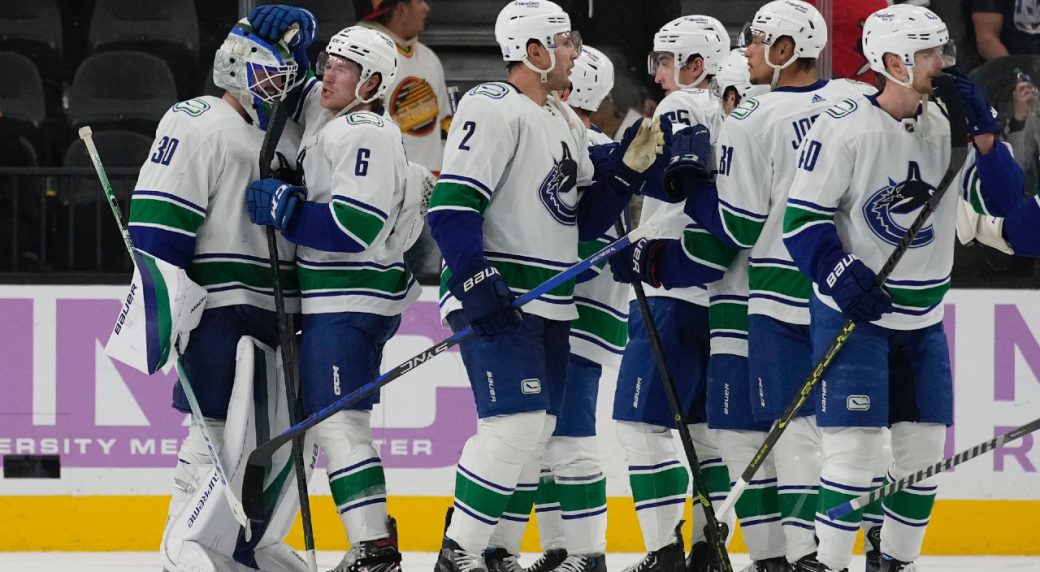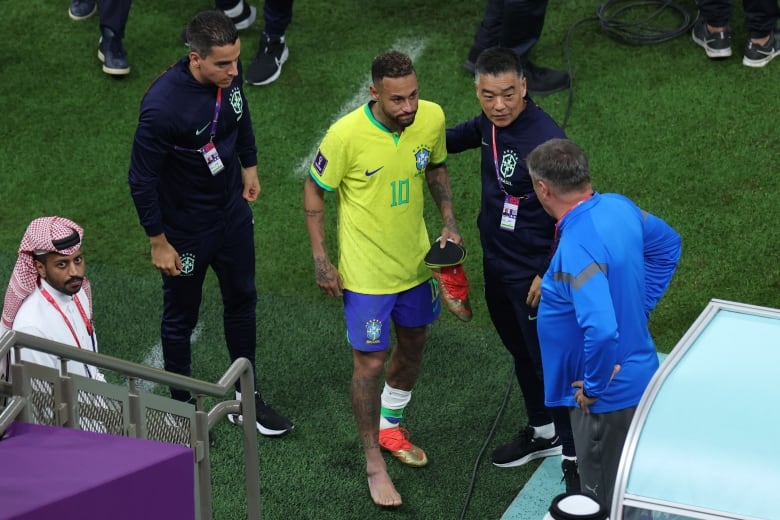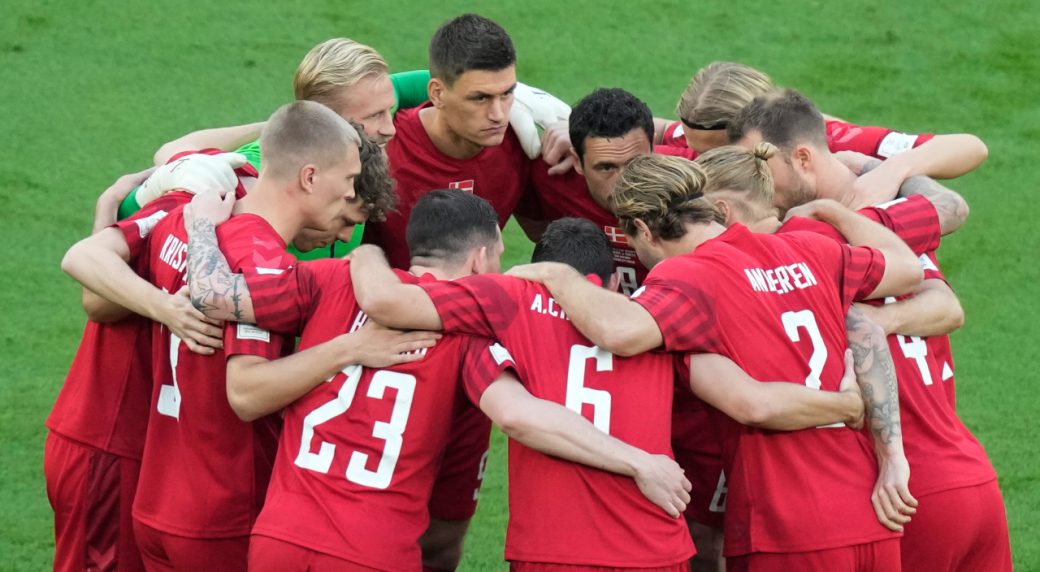It was all Sam Adekugbe could do not to laugh.
It was March 2018 and standing in front of the Canada defender was his new national team head coach, their fourth in a year and a half.
This new coach had plenty of rope, with a contract that would run through to 2026, when Canada would likely co-host the World Cup.
“My job isn’t for 2026,” he boldly proclaimed. “My job is for 2022.”
“And I remember being like, ‘What the f*** is this guy talking about?’” says Adekugbe.
Adekugbe’s disbelief is forgivable. Canada were minnows in international soccer at that point. Qualifying for a World Cup in four years fell somewhere between ambitious and impossible.
Unbeknown to Adekugbe, that meeting was being filmed. After Canada finished ahead of Mexico and the United States to qualify for a World Cup, that coach surprised the team by showing them a video of their faces when he made his proclamation.
On film, Adekugbe’s face was scrunched in scepticism.
“Not that I didn’t believe it,” Adekugbe insists, “it was just a big statement. But four years later, we are where we are.”

Adekugbe did not know how to take Herdman when he was appointed (Photo: VLADIMIR SIMICEK/AFP via Getty Images)
From the outside, few could have predicted that John Herdman would rise from being a primary schoolteacher in a small town in England to managing at the World Cup.
Canada are where they are, on the precipice of the most important soccer games in their history, because Herdman’s penchant for eschewing football norms could deliver unprecedented results.
As a child, Herdman did not always play by the rules.
He can say that now, from a comfortable neighbourhood outside of Vancouver, Canada, where he believes “everything is scripted”, for children, referencing how often he hears them being told exactly what time to be home for dinner.
That was not the case for Herdman in Consett, a town of 25,000 in north east England, 14 miles south west of Newcastle.
In its industrial heyday, a ruby red cloud literally hung over Consett. Steel-making was its lifeblood and for more than a century the community became economically dependent upon the metal trade.
Herdman’s family was no different. His grandfather, John, was a union leader at the steelworks and his father, Norman, earned his living as an electrician at the same place. Two generations of the Herdman family lost their livelihoods when the blast furnaces closed in 1980. Herdman’s father was eventually diagnosed with depression.
Where steel was once smelted, a Tesco supermarket now stands. It was in this financially challenging environment that Herdman grew up, with his family living in public housing.
Herdman’s parents divorced, leaving a young boy often on his own.
“If I wanted to go out and climb on a building roof with my mates after dark because you can’t play football anymore, we’d do that,” he says. “And because of that, I’ve never had the same sort of risk thresholds that other people I work with have.”
In 1993, a 17-year-old Herdman tested those thresholds when he boarded a flight to Spain and began chatting with the pilots. His cheeky side got the best of him, and while discussing the film Top Gun, he coyly asked if he had a bomb, what would happen?
“You’re not aware of the consequences of that sort of conversation,” he says.
Herdman was arrested once the plane landed in Spain before being released.
“A lot of learnings happened for me very young,” he says.
Learning became a central tenet to Herdman as he completed his degree in education at Northumbria University. Herdman played football, but never at any level of repute.
Paul Potrac, a professor at Northumbria, quickly saw how well Herdman spoke as a part-time lecturer. Potrac thought Herdman would have a distinguished career teaching in the same Consett primary school he grew up in, St. Patrick’s, until Herdman repeatedly pulled him into a small room in his flat after dinners together to let him in on his secret.
Herdman’s voice lit up in a profound manner when explaining how educational principles such as back-and-forth discussion instead of strict instruction could be applied to training sessions he would run at a local soccer school he had opened in the hopes of developing Brazilian-influenced technical abilities in players.
His approach was influenced by the coaching models of Chicago Bulls legend Phil Jackson and ex-England manager Bobby Robson, who he believed cared about people, particularly those who others had written off.
“There’s not many teachers who are new to education who combine the rigours of the classroom, particularly in the first couple of years of teaching, with running a coaching business in the evening,” says Potrac.
After word had spread about a primary school teacher engaging young players in newfound ways, Elliott Dickman, then a manager in Sunderland’s youth academy, recruited Herdman to work as an assistant coach with the under-9 side.
Like Adekugbe, Dickman stared in disbelief as Herdman integrated “weird and wacky” methods. Brazilian samba music was played during sessions to help encourage young players to move in a free manner as opposed to a formulaic one. Herdman would bring heavily-weighted size one balls in sessions to improve players’ manipulation and strength on the ball so during games they could move more freely.
Herdman had more sweat on him than some of his children because of his enthusiastic involvement.
“Back then it was quite a traditional way of coaching in the UK,” says Dickman. “You wouldn’t coach, you’d demand. Rather than tell, tell, tell, John was very much about asking players questions. ‘What do you think we should do in a 2-v-1 situation?’ he’d ask kids. The courage and bravery he showed to do what he did was outstanding.”
But not all of that bravery was appreciated. High-ranking coaches in Sunderland’s academy could not get over the fact Herdman had never played professionally. They were adamant: he would not progress beyond coaching under-9s because of that.
Dickman called that disbelief from Sunderland a “tipping point” for the young coach.
On the other side of the world, Potrac had taken a teaching job in Otago, New Zealand, and heard the local soccer club were looking for someone to take on a position as a coach and in coaching development.
Potrac recommended Herdman, who not long afterwards flew to New Zealand to, in his words, “move from copy to create”.
“The books, the website articles, I decided to silence that for a period of time,” he says. “It was time to build my own philosophy, my own approach.”
Herdman hit the ground running by taking a semi-professional Hibiscus Coast team that included Potrac and treating them like top professionals. He would show his team videos of how AC Milan prepared their build-up play through each of the thirds, likening each of the players, some of whom were part-time, to the likes of Clarence Seedorf and Andriy Shevchenko.
“We just learned so much from him: the detail of where to be, the timing of passes, the angles needed for certain movements,” says Potrac.
Coaching was about more than tactics for Herdman, though.
He thought back to his days as a teacher. Empathy would build trust, and would be his calling card.
Brent Edwards, one of Herdman’s players, remembers the coach coming to watch his sons, Nathan and Daniel, play soccer. On the sidelines, Edwards was vocal to the point of distraction. The following day, Herdman invited himself over to Edwards’ house with a few beers. Herdman surprised him with a video of an English coach berating players.
“What am I watching this for?” Edwards asked.
Herdman turned to Edwards: “That’s you, mate. And if you want your kids to carry on playing, you need to change.”
“I had tears in my eyes,” says Edwards.
If Herdman was going to shout, he wanted his words to make a difference. “Stay in the green” was one of his favourites. It was a reminder for players not to lose focus and keep their mind on the green of the pitch.
“If we were to make a mistake or things weren’t working out as we’d hoped, we had to remember to stay in the green,” says Potrac. “We’ve got to not dwell on it, not to go and hide, because there is temptation to do that on a football field.”
When Herdman moved into a more prominent role as head of football development for Football South, one of New Zealand’s regional federations, he ran coaching workshops.
“He was a very good actor — he was way ahead of his time and technology, as opposed to just talking and droning on,” says Jeff Walker, who was then the head of Federation Seven, Herdman’s designated federation.
The distance between the towns in the south island made for long drives. That is when Herdman began formulating an idea that he hoped would have wide-ranging implications. After travelling to see the way the top academy programs around the world, including Ajax, operated, he called his ambitious plan “The Whole of Football”.
Herdman travelled the country, getting all the necessary parties onboard.

Herdman coaching New Zealand Women in 2007 (Photo: TEH ENG KOON/AFP via Getty Images)
“He created unity. He felt that was the only way to create change,” says then CEO of New Zealand Football, Michael Glading. “And that’s hard when you’ve got parochial people who have always done things a certain way.”
Herdman wanted to empower New Zealand players between the ages of six and 12 to master technical skills as the brain continues to develop and feel confident playing with the ball. He believed if youth teams were aligned in their pursuits and created players with similar skill sets in each position, a more cohesive national team program would follow.
“People just used to float around with young kids until they got to 12,” Walker says. “John changed that and said, ‘No we’ve got to go to small-sided, we’ve got to concentrate on skill so that when the players get old enough to conceptualise the game, they’ve got the technical skills to participate properly.’”
More New Zealand players are now based in competitive leagues in Europe, including 20-year-old Matthew Garbett with Torino of Serie A.
“My guess would be that a lot of that is because of the work that took place with the Whole of Football,” says Tony Readings, former New Zealand Under-20 national team coach.
Herdman’s wide-ranging plans eventually caught the eye of the Football Ferns, New Zealand women’s national team. Their operating budget was as low as the expectations of the team, meaning Herdman had to lean into his “mad genius” side, a term he knows his assistants have long used with him. He was an early employer of analytics to help define success, utilising an All Blacks (the rugby team) analyst to help define the key performance indicators behind the aggressive style of play he wanted to deploy.
He employed people like Graeme Robson of High Performance Sport New Zealand, to hide out in nearby trees to film his sessions, and sometimes pipe instructions into his ear via headphones on how to improve. To this day, Herdman’s AirPods, connected to his coaching staff, have become a staple of his touchline look.
“He wanted to push the boundaries to see if things worked,” says Readings, who Herdman had met in a coaching development workshop and brought on as an assistant.
There was still more learning to be done, which, as Herdman admits, there always is. During a coaching seminar ahead of him picking his first Ferns teams, Herdman sat alongside Robson while New Zealand rugby league coach (Brian McClennan) discussed the importance of selecting players based on character. Robson remembers John putting his face in his hands, and muttering quietly: “I’ve just selected our team, and I haven’t considered that at all.”
“That was possibly the start of him getting rid of older players for younger ones,” says Robson. “We know the best coaches are lifelong learners.”

Herdman coaching in New Zealand (Photo: Jeff Walker)
And Herdman learned to keep negativity out of the team’s dressing room by setting attainable goals: after a 5-0 thrashing by Brazil in their opening match at the 2007 World Cup, Herdman wanted his team to focus on process over results, utilise their defending skills and keep the next two games within two goals. They succeeded, and performances improved.
After the World Cup, Herdman had conversations with Victor Montagliani and Peter Montopoli of Canada Soccer about taking over their women’s team.
“John had something that was different from anyone else,” says Montopoli. “He had the intangibles.”
Still, they elected to wait and see if those intangibles could translate into results.
Herdman believes the most notable turning point in his career came during the 2008 summer Olympics, when New Zealand made their first appearance in the women’s soccer tournament. They drew with eventual fourth-place side Japan 2-2 and were narrowly beaten by Norway.
“It was the first time I felt a group of players overachieved,” he says. “I understood then that there’s a Holy Trinity around where I have to spend my time as a coach: team spirit, tactical excellence, team chemistry. And if I’m working outside of these frameworks, I’m wasting my time.”

Herdman uses his AirPods during games (Photo: ANDY JACOBSOHN/AFP via Getty Images)
After not scoring a single goal at the 2007 World Cup, the Ferns scored in each of their three matches at the 2011 tournament and managed a draw. One of the other teams at the tournament was Canada, who left with a worse record than New Zealand.
Not long afterwards, Montopoli called Herdman.
“John,” says Montopoli, “it’s time.” Herdman’s response? “I know.”
Canada women were in disarray. Some veteran players were contemplating early retirements until Herdman arrived.
“He instantly stepped into our environment, reinvigorated the team and created a light at the end of the tunnel that was not there,” says former player Robyn Gale.
Herdman’s vision involved elevating the women’s team to new heights. To unify the team, he would display a photo of Christine Sinclair, their greatest player, in tears on the pitch after the 2011 World Cup. He challenged players to hit their personal bests for her. For some, that meant moving up to clubs of higher statures. For others, that meant positional changes.
“A lot of people can present a vision,” says Gale. “But it’s very evident in everything that he does that there’s just a different level of care and diligence around the details.”
Gale chuckles as she says the word “details”, immediately feeling overwhelmed by the level of effort Herdman puts into preparation. Canada defender Alistair Johnston recently recalled being sent a 64-page document laden with in-depth statistics and heat maps to prepare players for… one of their World Cup opponents.
That preparation guided the women’s team to an improbable quarter-final win over Great Britain in the 2012 Olympics. Controversial refereeing resulted in his team losing to the United States in the semi-final before they claimed bronze.
Herdman and his team were overachieving, and looking world-class in the process.
In 2015, Herdman gave a TED Talk, sharing the lessons learned from the team’s 2012 Olympic performance.

Herdman played an integral role in Canada’s rise to prominence in women’s soccer (Photo: Christopher Morris/Corbis via Getty Images)
“If you want to reach greatness, and that’s what (the Canadian women’s national team) had to buy into, they had to achieve consistent goodness in every part of their life, and not only when people were watching,” he says. “Great people do it when nobody’s watching.”
As the 2016 summer Olympics approached, Herdman wanted as many voices around him as possible and his methods questioned to see how they could be improved.
Dr Penny Werthner, a sports psychology consultant, helped Herdman remain open to criticism and ensured his team felt comfortable asking questions.
Internal conflict within the team meant he had to step back from his inherent emotional side and not just try to coax a change out of his players. In meetings, Herdman put his team into specific small groups to discuss how they would like to play in games, which created a greater sense of team harmony.
“That’s ownership and autonomy for the players on the field, which he cultivated,” says Werthner.
Canada was the only team to win every game in the group stage and they overcame a hostile environment in Sao Paulo to beat Brazil 2-1 for the bronze medal.
It became clear Herdman may have taken the team as far as he could. A new challenge was needed. Though not in charge of the women’s team that won gold at the 2020 Olympics in Tokyo, his players finished the job he had started.
“His fingerprints were all over it,” says Montopoli.
Canada did not want to lose those fingerprints. When Herdman was offered the head coach job of England’s women, he believed his time in Canada was done. At the same time, Canada’s men’s team had exciting teenage prospects in Alphonso Davies and Jonathan David coming through. Then-head coach Octavio Zambrano did not appear as committed to overhauling the men’s program.
Another failed performance in qualifying for the 2022 World Cup would be an embarrassment for Canada as co-hosting the men’s World Cup in 2026 was a real possibility.
“We had to get it right, right away,” says Montopoli. “It just made bloody sense that the next step of the evolution was John.”
Convincing the men’s team of their potential proved difficult. During his first camp, multiple fist fights broke out as the team broke into fractured cliques. Herdman was met with derogatory comments about these kinds of occurrences being common in the men’s game and “not the women’s game”.
He wanted to appeal to the team’s young core as a teacher but more drastic measures were necessary.
Having filmed training via a drone, Herdman pulled his team together to show them footage of the aftermath of the punch-ups rather than the session. Players from different backgrounds stuck together, and walked their separate ways when the fights broke out.
Englishmen in charge of other WC teams
| Manager | Country | World Cups |
|---|
Bob Glendenning | Netherlands | 1934 & 1938 |
Sid Kimpton | | |
Jack Butler | | |
George Raynor | | 1950 & 1958 |
John Adshead | New Zealand | |
Tony Waiters | | |
Jack Charlton | Republic of Ireland | 1990 & 1994 |
Roy Hodgson | Switzerland | |
John Herdman | | |
“’This is why you’ve not qualified for a f***ing World Cup. Unless you f***ing fix this, we are going nowhere,’” he remembers telling his team. “Because when the s*** hits the fan, when things get tough, this team splits.”
Herdman called dozens of past Canada players to understand why things generally go wrong. In-fighting and cliques were natural, he heard.
There was a belief that Canada had the talent to get to a World Cup, however. So Herdman began creating a culture defined almost exclusively by one word: brotherhood.
Qualify for the World Cup, he told his team, and you will go down as heroes who changed the sport forever.
But, he would add, the only way that would happen is if players stopped worrying about who might take their places. If they tried to learn more about each other as people and celebrate each other’s success, success would follow.
“Tactical excellence doesn’t work unless people have trust and safety in each other and the reasons we’re here,” Herdman said.
In the months afterwards, a difference in the tenor of the group emerged. Any single bit of success a player experienced with their club brought congratulatory messages on the team’s group chat. Players began to accept that if they weren’t playing, there were other important roles to fill.
Doneil Henry was once a first-choice centre-back who has toiled through difficult times with the team to earn a World Cup spot. But Henry understood Herdman’s message and gladly took on the role of locker room connector.

Johnston, two, and Milan Borjan, lead the Canada celebrations after beating the U.S. 2-0 in January (Photo by Vaughn Ridley/Getty Images)
If a player emanates an ego in the room that is detrimental, or an evident fear that their place in the squad will be taken, he will not get the call back into the team.
“This is a lifestyle now,” Henry says of playing under Herdman. “We go to the national team and then you go back to your club and you’re thinking, ‘We should do things differently’.”
Herdman sensed the runway he had in front of him to develop young players, once naming six teenagers in a team including giving a shy, unproven David his first start as an 18-year-old.
“As a young player, sometimes you lack confidence,” said David in 2018. “When a coach has that confidence in you, it makes you play at that highest level.”
David scored three goals in his first two starts.
“Right at the front of my mind is pushing human potential,” said Herdman, “to places where they never thought they could go.”
Even as Canada faced such a long road to Qatar,Herdman remained ambitious. He wanted Canada to finish at the top of the final round of CONCACAF World Cup qualifying.
He dived deeper into the player pool, finding diamonds in the rough such as Johnston, a reliable defender who was playing semi-professional soccer just two years earlier. He was persuasive in convincing dual nationals to join the Canadian side, including midfielder Stephen Eustaquio, now a Champions League starter with FC Porto.
What he sold them on was the brotherhood he had instilled. Senior players like Milan Borjan became Herdman’s loudest champion, not only working to contribute to the brotherhood, but singing his praises.
After Canada completed an improbable win over the United States in qualifying without Davies, Borjan was asked the secret behind the team’s turnaround.
“I can say just two words,” said Borjan, “John Herdman.”
In the months after qualifying, Herdman de-briefed with players and to a man, they agreed that unity would be part of what could make them a dangerous team in Qatar.
A skeptical group, and country, had bought in.
Adekugbe says it was personal conversations he had with Herdman which propelled him from a player of potential in 2018 to a regular starter at Hatayspor in Turkey and the player whose stock rose the most during World Cup qualifying.
“This qualification process, I wasn’t playing to showcase myself,” insists Adekugbe. “I was playing to qualify with my brothers.”
That includes Henry. After the defender suffered a calf injury in the warm-up ahead of a November friendly against Bahrain, it was determined he would miss at least 14 days. Instead of demanding a spot on the World Cup roster and possibly playing in Canada’s last game, Henry opted to give his spot to another player.
Herdman rewarded Henry’s trust by bringing him to Qatar to assist the team.
Despite being outsiders to advance out of their group, Canada have the same belief they had throughout qualifying. They have Herdman to thank for that.
“Everyone has to be fully committed and bought in,” says Henry. “And that’s how we did it. And John believed in it.”
(Additional contributor: Chris Waugh)
(Design: Sam Richardson for The Athletic)
Adblock test (Why?)
https://news.google.com/__i/rss/rd/articles/CBMiSWh0dHBzOi8vdGhlYXRobGV0aWMuY29tLzM4OTg3MDIvMjAyMi8xMS8yMy9qb2huLWhlcmRtYW4tY2FuYWRhLXdvcmxkLWN1cC_SAQA?oc=5
2022-11-23 05:09:55Z
1649686472
























